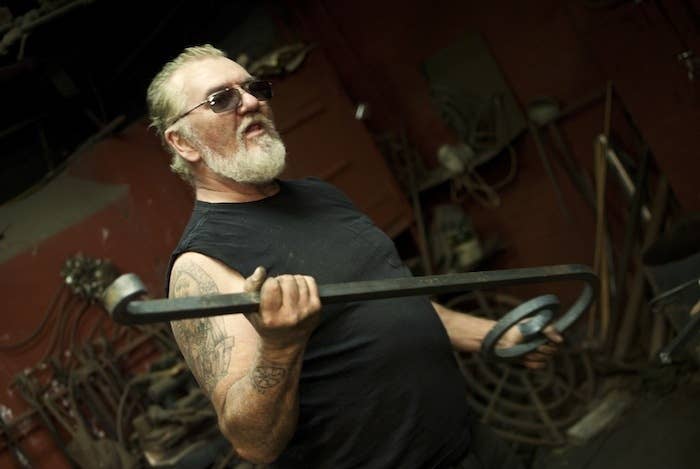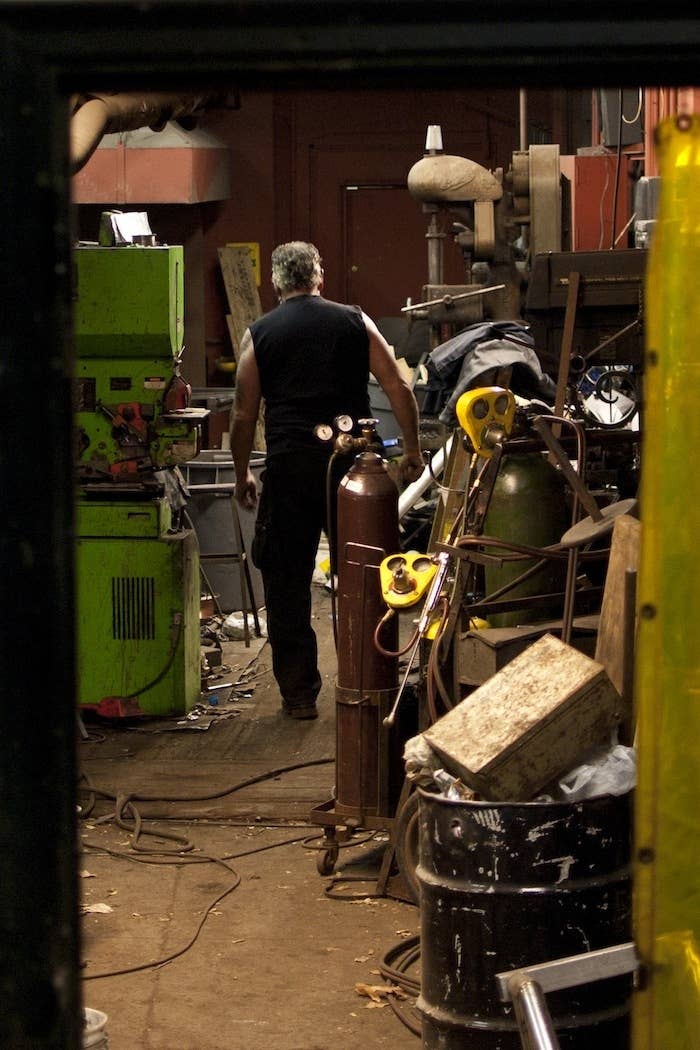
Larry Hagberg looks like a guy who hammers steel for a living. He's tall with large tattooed arms and a barrel chest. His hair and beard are silver, his hands black with soot. He’s a throwback to a forgone era of ruggedness, not just the kind of guy who has a workshop but one who tightens bolts by hand. He was bending scrolls for the fence at Peter Detmold Park in Midtown when I visited his workshop.
“Rather than just put a straight piece of iron,” he said. “It's a nice street, so I figured I'd make something like this, so when you look at the fence it doesn't look like a bunch of iron bars.”
Born in Bushwick, Brooklyn and raised in Ozone Park, Queens, Hagberg started metal working in 1976. As a teenager, he worked at the the Broken Wheel Ranch in Round Top, a small upstate town near Cairo, New York, where he was first introduced to horseshoeing. He joined the City’s Parks Department in 1984 and has spent the last 30 years “heating and beating” metal into fences, gates and locks for use throughout the city. Some of his favorite pieces include a lock and key for an old lamp post in Union Square and a gate on Central Park’s Arsenal.
Today, the parks department’s forge continues burning in the middle of Central Park, near 86th Street, in a century-old stable building. At its height, the workshop housed five blacksmiths and four “helpers,” though today they’re down to just three smiths. It smells of burning coal and is packed with metal scraps that will one day be reshaped or melted down.
I visited Hagberg at his workshop to learn more about his craft and where blacksmithing fits into modern life in New York City. At 61 years old, he's still animated and jovial, with a laugh as big an anvil, and always ready to impart his knowledge on the uninitiated, filtering his anecdotes through a throaty Brooklyn brogue.

Robert Tutton: How did you get started?
Larry Hagberg: I was a horse-shoer. I worked on a ranch when I was a kid up until I was 16. I got to know the guy who used to shoe the horses. I liked horses, and that was a job where you could be around horses. So when I came back here after a couple of years passed, I hooked up with the guy who was shoeing the horses for the carriage stables. … I worked with him for a year or two, then I went to horseshoeing school and became a farrier. Then this job came up. There used to be a city-wide test. All the agencies had blacksmiths at the time. Now the Fire Department, DOT, Parks and Sanitation still have blacksmiths. There was a written test, and if you passed that, you’d take a practical test which you had to forge a chisel and make a ring to a specific size. This is a dream job for blacksmiths. How so?
Have you ever been to Hansborough pool? They were going to put roll down gates in front of the computer room, so the deputy chief of operations says, “ask if he wants to make a pair of gates.” So I made these two nice gates, 11 feet. I made the lock and key, like an old jail key. It came out beautiful. I love that thing.
What drew you to metal work?
I don't know, I got an artistic side. I got drawn in, there was nothing I could do about it.
Are people surprised when you tell them what you do?
It's surprising that I'm a blacksmith in 2013 in the middle of Central Park. People are surprised sometimes because it's a dying craft. In the mid ‘60s, it was almost dead. There was very few blacksmiths at the end of the ‘50s, early ‘60s, so the ones that were still working taught younger people, and I think in the early ‘70s they formed the Artists Blacksmith Association of North America. It had a big resurgence, especially now when everything is made out of the country. When you have something that's hand made, it's an heirloom. It's not just something you buy from China and throw away when you move.


